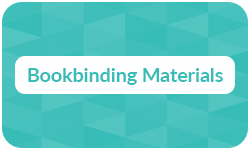
Bookbinding is the fascinating craft of forming a physical book. For centuries, people have been binding books to store knowledge for the next generations. Today, books are often used for entertainment or scientific research. However, to true book lovers, physical copies are still highly valuable. The following article will dive into the materials needed to bind a book, giving a brief overview.
Definition: Bookbinding materials
Bookbinding materials are, as the name suggests, materials needed to bind a book. Whether it is a hardcover binding or a paperback, every book needs a cover and the content — the manuscript. The former one is often made from a sturdy board, sometimes enveloped in cloth or fabric, or embellished with print finishing.
Hardcover with individual embossing
- Professional binding for thesis, dissertation, or books
- Price calculator and 3D live preview
- Print on demand with fast delivery right to your doorstep
Learn more!
Binder’s boards and tools
Binder’s boards are the sturdy base of a hardcover bookbinding, made from different materials depending on the manufacturer’s preferences. There are a few different options of materials you can use, which will be explained in the following. Furthermore, there are other tools you need for bookbinding, such as a paper press, a folding bone, an awl, and others.
Fabrics and other materials
Today, most cover images are printed directly on the paper-covered board. However, more old-fashioned or stylish versions prefer a cover wrapped in cloth, fabric, leather, or other materials. The following table briefly describes the different types of binding materials to use.
Gauze
Gauze in bookbinding refers to a material similar to that of bandages. It is usually used as a double gauze and glued onto the spine of the book block to secure the pages.
Muslin
Muslin is a material similar to gauze, only that the material is woven more loosely, and it uses only a single layer, while being sturdier than gauze.
Book cloth
Book cloth includes many types, such as linen, cotton, silk, velvet, or synthetic fabrics, depending on the budget and preferences of the maker.
Buckram
Buckram is also a type of book cloth, that is made from cotton, linen, or a mixture of both of them. It is very durable and thus favored for bookbinding.
Paper
Paper is very versatile for bookbinding, as it can be imprinted. It is a rather cheap solution that finds wide application in the modern book printing industry.
Leather
Leather is usually made from animal skin. However, you can also find vegan alternatives that are either synthetic or plant-based. It adds a luxurious finish to the product.
Parchment
Parchment is also made from animal skin, but does not undergo acidic tanning. This means that parchment decomposes more easily.
Bookbinding glue
To attach the boards to the fabric or the pages to the spine, you will need bookbinding glue. Industrial publishing companies widely use different types of synthetic glue. However, if there is a need for more natural adhesives, vegan or not, there are also many alternatives available due to higher demand for sustainable materials.
Bookbinding is not only a question of aesthetics, but also of eco-friendliness, since paper does use plenty of resources in water and also wood. Therefore, using sustainable alternatives in all areas of bookbinding is important to not strain nature more than necessary.
Waxed thread
If you choose not to glue the book spine of the book but sew it, you will need waxed thread. The wax reduces the possibility of knots while sewing, aiming for a smooth process. The typical bookbinding thread is made from cotton or linen, which can be waxed with a simple block of beeswax.
There are, however, also ready-made waxed threads to buy, which reduces the mess of waxing the thread yourself. This also saves time in the bookbinding process and helps to get a clean product at the end, since self-made waxing might result in wax clumps sticking to the thread or areas being left out.
The manuscript
Before you can even think about binding, you first have to write and print the manuscript. For this, you first have to consider what type of printer paper should be used.
Thin paper might seem suitable for very thick books, so the size of the book stays manageable, but on the other hand, if the paper is too thin, double-sided printing might shine through and lower the readability.
In professional bookbinding, the machine binding the book also needs to be taken into consideration, as it might only be able to handle a certain range of paper weights or different printer paper types.
Paperback with your individual design
- Individual design for thesis, dissertation, or books
- Use a customizable pre-made design or create your own
- Order online with fast delivery right to your doorstep
Learn more!
FAQs
To bind a hardcover book, you need a board, fabric or paper, and bookbinding glue. The board is glued to the fabric or paper for a smooth appearance before the book block is either also glued or sewn to the spine.
Buckram is a material made from cotton or linen, or a mixture of both of them, in a loosely woven fabric that is used to wrap the binder’s board of a hardcover book.
There is no one-answer solution for this question, as it all depends on the budget or personal preferences. If you want to dive into specific designs, using a simple paperback or paper-covered hardcover might give you the best opportunities. Durability-wise, leather or Buckram might be the best choice to give your book a durable and beautiful finish.
The term “binder’s board” refers to the sturdy plate in a hardcover that can be made from different materials such as cardboard, plastic, or even wood.